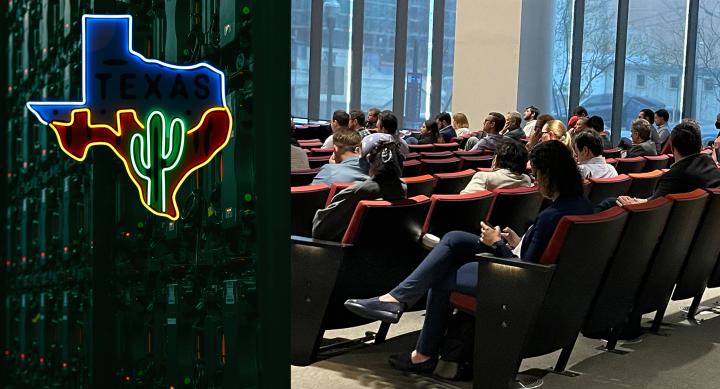Brian A. Korgel and Tiffany Wu (2025) Navigating the unprecedented energy demands and grid reliability challenges driven by industrial growth in Texas: Findings from the 2025 Large Load Symposium at The University of Texas at Austin. The Energy Institute at The University of Texas at Austin. https://doi.org/10.26153/tsw/61132
Brian A. Korgel, Shipra Mishra, Tiffany Wu, Timothy Seaton, and Callie Boggs (2025) Advancing Large Load Integration and Reliability Solutions in Texas: Proceedings from Phase 2 of the 2025 Large Load Symposium at The University of Texas at Austin. The Energy Institute at The University of Texas at Austin. https://doi.org/10.26153/tsw/62241
Background
The growth of artificial intelligence (AI) data centers in Texas has the potential to meaningfully boost local economies. It also presents challenges in energy demand and grid reliability.
Read here for more about The Texas Initiative for Datacenter Energy and Large Loads (TEX-DEL)
Data centers require significant power, typically ≥75 MW, which qualifies them as large loads by the Electric Reliability Council of Texas (ERCOT). With the addition of a substantial number of data centers and other large loads due to steadily increasing electrification of industrial and manufacturing processes, ERCOT is anticipating a consequential rise in power demand in Texas by 2030. This has the potential to strain the energy system in Texas without strategic planning, especially in rural regions where the grid infrastructure is not as resilient as it is in the urban population centers.
To address the urgent challenges posed by the rapid growth of large, power-dense loads, particularly artificial intelligence (AI) data centers and crypto mining operations, The University of Texas at Austin convened a “Large Load Symposium,” bringing together sixty-five representatives from the Public Utility Commission of Texas (PUCT), ERCOT, Texas Reliability Entity (TRE), industry—including transmission service providers, load developers, technology providers, equipment manufacturers, generators—as well as regulatory and academic experts.
The Phase 1 Symposium included presentations from TRE and ERCOT, followed by structured breakout sessions. Participants discussed growing concerns around ERCOT's ability to manage near- and medium-term large load growth and were asked to (1) define the scale and nature of the challenge including voltage stability, thermal constraints, and resource adequacy, (2) assess existing capabilities and risk mitigation technologies, and (3) identify actionable market and policy solutions. The dialogue that emerged highlighted the need for updated interconnection processes, clear performance standards, and better coordination across load developers, utilities, and system operators.
The Phase 2 Symposium moved this work forward through hands-on working session focused on co-creation and design. The session brought the same representatives to collaboratively develop frameworks, templates, and prototype tools that support large load interconnection readiness. The breakout objectives were (1) draft an Large Load Interconnection Agreement (LLIA) aligned with anticipated rulemaking requirements, (2) map the full end-to-end interconnection process for large loads, identify key milestones, study inputs, decision points, and communication pathways, (3) design a conceptual prototype for a Load Resource Integration and Ongoing Operations (RIOO) platform, and (4) examine how large loads interact with grid during emergency conditions.
Outputs from Phase 2:
Large Load Interconnection Agreement: This group proposed creating a standard, milestone-based LLIA framework to replace today’s utility-by-utility approach. The recommended structure includes (1) a Study Agreement to formalize intake and define scope, (2) an Interim LLIA to secure financial commitments and preserve schedule, and (3) a Final LLIA to authorize construction and set operational expectations. Standardizing these agreements would clarify roles among the Electric Reliability Council of Texas (ERCOT), transmission/distribution providers, and customers; reduce negotiation time; and support more predictable interconnection outcomes statewide.
Large Load Interconnection Process: This group recommended replacing the current iterative, restudy-heavy approach with a system-wide, coordinated process. Core elements include a cluster study model with set study windows and sequencing rules, uniform screening and security requirements to keep speculative projects out of the queue, and codified communication protocols so ERCOT, Transmission Service Providers (TSPs), Distribution Service Providers (DSPs), and developers follow the same process steps. The group also emphasized making Large Load Interconnection Study (LLIS) results directly actionable in ERCOT’s planning workflow and increasing ERCOT/TSP study capacity to handle the rising volume of large load requests.
Load Interconnection Status Dashboard (LIOO): This group focused on improving process visibility and accountability through a centralized digital tracking platform. Modeled on ERCOT’s Resource Integration and Ongoing Operations – Resource Service (RIOO-RS), the proposed Load Interconnection and Ongoing Operations (LIOO) dashboard would display project status, responsible entities, and milestones in real time. Features would include role-based permissions, automated status notifications, and built-in audit trails. The goal is to reduce the current “black box” experience and improve coordination across multiple utilities and developers.
Emergency Operations: This group addressed gaps in communication and load management during grid stress. Participants recommended creating a unified communication framework between ERCOT, TDSPs, Qualified Scheduling Entities (QSEs), and Market Participants; adopting standard load-ramping procedures so curtailment is not just on/off; and refining ERCOT Protocol 6.5.9 to explicitly cover forecasted scarcity and Operating Condition Notice (OCN) events. Under the proposal, ERCOT would issue OCNs, coordinate with Transmission Distribution Service Providers (TDSPs) to defer outages, and pre-identify large loads (≥75 MW) for managed ramping under established emergency procedures.
Key takeaways from Phase 1 included:
- Loads are coming online faster than grid processes can accommodate.
- Voltage and frequency ride-through (VRT) capabilities are the most urgent technical hurdle. Load developers need certainty that their interconnection timelines will not be affected by updates to models or mitigation efforts.
- Lack of standardization in interconnection agreements, study assumptions, and modeling guidance is a core barrier.
- Stakeholders support technical conferences to inform standards and clearer guidance from regulatory bodies.
- Greater data transparency, communication and coordination, and incentives for flexibility are needed.
Several actionable solutions were identified:
- Develop a standardized Large Load Interconnection Agreement (LLIA): ERCOT, PUC, and transmission service providers (TSPs) should jointly define modeling expectations, timelines, data requirements, and pass/fail criteria.
- Create a system-wide study milestone dashboard or reporting platform:
Enable TSPs, ERCOT, and loads to track study progress and avoid duplicated efforts. If ERCOT cannot develop this in a timely fashion, it could be outsourced. - Define interconnection protection rules for data/model updates: ERCOT should clarify that providing updated models will not automatically trigger a restudy or jeopardize energization scales or timelines.
- Launch a technical working group (ERCOT, TSPs, loads, original equipment manufacturers (OEMs)): Form a standing body to co-develop standards, validate models, and resolve technology feasibility questions. Iterate to move quickly.
- Standardize load modeling inputs and formats: ERCOT should release templates for dynamic profiles, battery energy storage system (BESS) configurations, ramp rates, and mitigation options.
- Create a third-party modeling data center or repository: Allow loads to submit data to a neutral entity for model review and validation outside the ERCOT formal process, i.e. “third party review.”
- Require telemetry for large loads ≥75 MW: Loads should provide real-time or near-real-time load profile data to ERCOT and TSPs.
- Define coordinated communication protocols for load development schedules: Loads must communicate expected load development schedule and operating profiles in advance; ERCOT to provide standardized formats and timelines.
- Enable BESS and microgrids as part of VRT compliance pathways: ERCOT should recognize co-located solutions like BESS and grid-forming microgrids in lieu of full system upgrades.
- Create dual-track ancillary service paths: one for frequency, one for VRT
Allow loads with onboard BESS to participate in Fast Frequency Response (FFR) and localized voltage ride-through mitigation. ERCOT’s information technology (IT) system change constraints could limit options, so there could be a need to creatively manage this. - Pilot voluntary “readiness reviews” prior to formal interconnection: ERCOT and TSPs could review load models informally before formal submission to flag gaps.
- Host a technical conference before implementing VRT standards: Gather load developers, inverter vendors, battery suppliers, ERCOT, and engineers to align on what’s feasible.
Contact
Supported By





